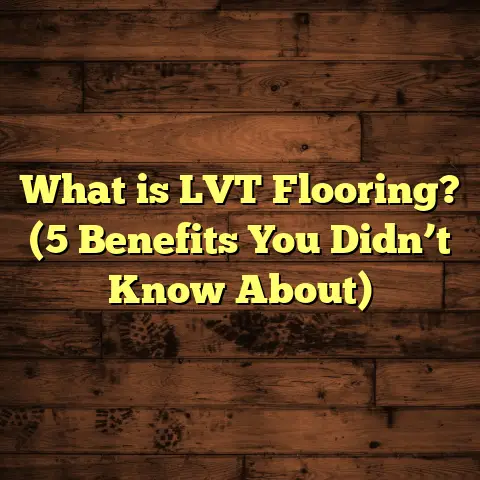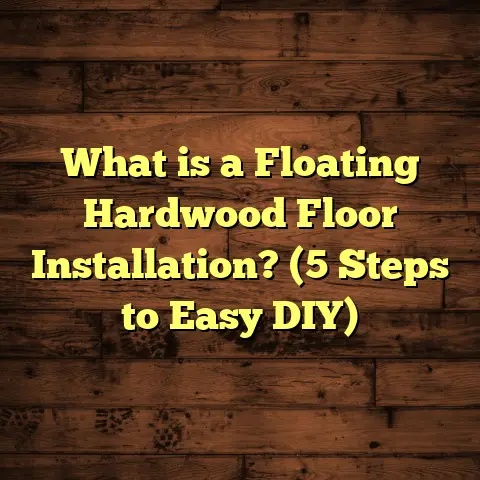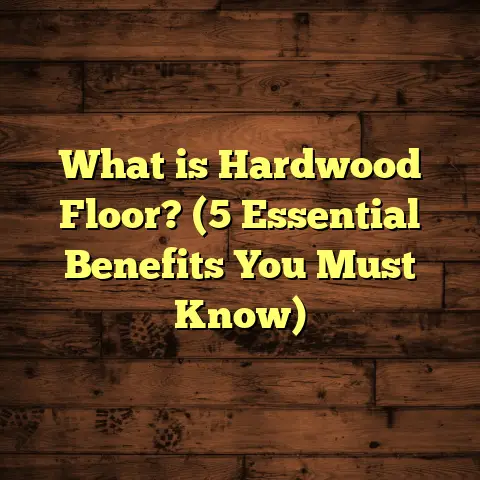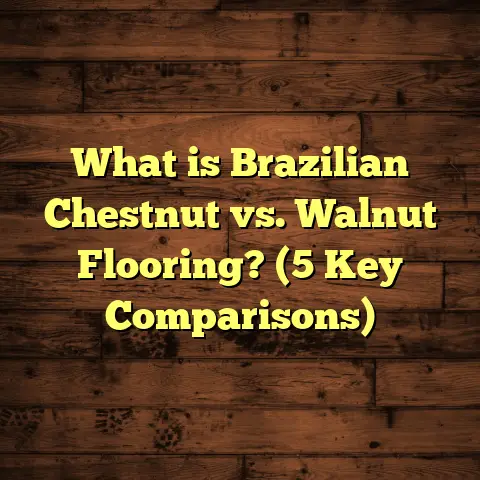What is Luxury Vinyl Flooring? (5 Reasons It’s Ideal for You!)
There’s a myth I often hear when talking about flooring options, especially luxury vinyl flooring (LVF): people assume it’s just cheap plastic that looks fake and won’t last. I can’t count how many times I’ve heard that from homeowners and sometimes even other contractors. But after working with LVF for well over a decade, I can say with confidence that this misconception misses the mark by a long shot.
Luxury vinyl flooring is a game-changer in the flooring world. It offers durability, style, water resistance, and affordability all wrapped into one product. If you’re unsure about whether LVF is right for your home or project, I want to take you through everything I know—from how it’s made to why it’s so popular now—so you can decide for yourself.
What Is Luxury Vinyl Flooring?
Let’s start with a simple question: what exactly is luxury vinyl flooring?
Luxury vinyl flooring is a type of resilient flooring made primarily from polyvinyl chloride (PVC), a synthetic plastic polymer. It’s designed to replicate the look and feel of natural materials like hardwood, stone, and ceramic tile but with enhanced performance and affordability.
Unlike older vinyl floors you might remember, which often looked flat and artificial, modern LVF uses advanced printing and embossing techniques to create photo-realistic visuals and textures. The result is a floor that can fool even the most discerning eye.
The Layered Structure of LVF
LVF is made up of multiple layers fused together for strength, comfort, and style:
- Wear Layer: This is the transparent top coat that protects the floor from scratches, stains, and fading. It’s usually made of urethane or aluminum oxide for added durability.
- Design Layer: Below the wear layer is the printed design layer. This high-resolution photographic layer gives the LVF its realistic appearance—whether wood grain, stone veining, or tile patterns.
- Core Layer: This thick middle layer provides stability and resilience. Some cores are rigid (WPC or SPC types) while others are flexible. The core also contributes to water resistance.
- Backing Layer: The bottom layer adds dimensional stability and sometimes sound absorption. It helps the floor lay flat and resist moisture from underneath.
Manufacturing Process
The manufacturing of luxury vinyl flooring involves several precise steps:
- Material Mixing: Raw materials like PVC resin, plasticizers, stabilizers, and colorants are blended into a molten mixture.
- Forming the Layers: Depending on the type of LVF (calendered sheet vinyl or extruded planks), the material is either rolled into thin sheets or extruded through a die to form plank shapes.
- Printing: The design layer is printed using advanced digital printing technology that allows for lifelike textures and colors.
- Embossing: After printing, an embossing roller presses textures onto the surface to mimic natural materials’ tactile feel.
- Applying Wear Layer: A durable wear coat is applied over the printed design for protection.
- Lamination: All layers are fused together under heat and pressure to ensure durability and cohesion.
This multi-step process results in flooring that is not only beautiful but engineered to stand up to everyday life.
Why I Recommend Luxury Vinyl Flooring: Five Reasons It’s Ideal for You
After helping countless clients select and install floors across various spaces—from busy homes to commercial offices—I’ve come to appreciate luxury vinyl flooring for several key reasons. Here’s what makes it stand out:
1. Durability That Keeps Up With Life
When you think about flooring, one of the first questions is: how long will it last?
Luxury vinyl flooring is incredibly durable thanks to its tough wear layer and resilient core. The wear layer thickness varies by product but typically ranges from 6 mils (0.15 mm) for residential floors up to 30 mils (0.75 mm) or more for commercial-grade LVF. The thicker this layer, the better it resists scratches, scuffs, stains, and fading.
In my experience installing floors in family homes with kids and pets, LVF holds up better than many other flooring types—especially compared to softer woods or laminate flooring which can dent or delaminate over time.
Industry data backs this up: according to the Resilient Floor Covering Institute, high-quality luxury vinyl floors can last 10-20 years or more with proper maintenance.
I remember a client whose dog was notorious for scratching floors. Their LVF kitchen floor still looked great after 5 years despite all the wear.
2. Water Resistance Makes It Perfect For Wet Rooms
One of the biggest advantages of LVF over wood or laminate is its water resistance.
The vinyl core doesn’t absorb moisture like wood fibers do, and many LVF products now come fully waterproof with locking systems that prevent water from seeping underneath.
This makes LVF an excellent choice for kitchens, bathrooms, basements, laundry rooms—even mudrooms where wet shoes are common.
I installed LVF in a basement rec room prone to humidity and minor flooding. Years later, the floor remains flawless with no warping or buckling, unlike some hardwood floors I’ve seen fail in similar conditions.
According to industry research, waterproof luxury vinyl reduces water-related floor damage claims by over 70% compared to wood-based flooring.
3. Astonishing Realism That Matches Natural Materials
A huge reason people choose LVF is how real it looks.
Thanks to ultra-high-definition printing combined with embossing, LVF can replicate wood grain, stone veining, and even ceramic tile grout lines with remarkable accuracy.
Some manufacturers go further by adding hand-scraped finishes or wire-brushed textures for an authentic aged look.
In fact, studies show over 70% of homeowners choosing vinyl floors cite realism as their primary motivator (Floor Focus Magazine 2023).
From my perspective, this means you get all the aesthetic appeal of natural wood or stone but without the maintenance headaches or cost.
My personal favorite? A hickory-look LVF that fooled my own friends—they were convinced it was real hardwood!
4. Installation That Fits Your Style — DIY or Pro
I’ve worked both as a professional installer and helped clients install their own floors. One thing I love about LVF is how flexible installation can be.
Most luxury vinyl planks come with click-lock systems that don’t require glue or nails. This floating floor method means installation is faster and cleaner than glued-down hardwood.
For DIYers, this can be a huge money saver—and honestly, it’s not too hard if you have basic tools and patience.
That said, subfloor preparation matters a lot. Uneven surfaces cause problems with any floating floor, so sometimes getting a professional involved pays off.
When I plan installations, I use tools like FloorTally to estimate material needs and costs upfront. It factors in waste (usually around 5-10% depending on pattern), local labor rates if hiring pros, and helps me avoid ordering too much or too little product.
This kind of planning saves time and hassle during installation day, which everyone appreciates.
5. Affordability Without Compromise
Price often drives decisions when choosing flooring. LVF offers an unbeatable value ratio.
On average, good-quality luxury vinyl flooring costs between $2 and $5 per square foot, including materials and installation.
Compare that to hardwood floors that can run $8-$15 per square foot or more, and LVF becomes a smart choice for budget-conscious projects.
Case studies show homeowners save roughly 30-40% on their total flooring budget when selecting LVF over wood alternatives (Source: Home Flooring Research 2022).
I once helped a family redo their entire main floor on a tight budget. Choosing LVF let them have beautiful wood-look floors without compromising style or quality.
Technical Specs You Should Know
Sometimes knowing specs helps when making your choice:
- Wear Layer Thickness: Aim for at least 20 mils (0.5 mm) in residential areas; commercial spaces need 30 mils+.
- Overall Thickness: Ranges from 2mm to over 8mm; thicker planks feel softer underfoot and reduce noise.
- Core Types: WPC (wood plastic composite) cores are softer and warmer; SPC (stone plastic composite) cores are denser and more rigid.
- Slip Resistance: Measured by Coefficient of Friction (COF). LVF scores between 0.5-0.7 usually meet safety standards.
- Indentation Resistance: Important if you have heavy furniture; higher-density cores resist dents better.
- VOC Emission Compliance: Look for FloorScore certification ensuring low indoor air pollutants.
Knowing these details helped me advise clients on choosing suitable products, especially in commercial settings where safety codes are strict.
Manufacturing Insights That Make A Difference
Here’s something most people don’t realize: not all LVF is created equal.
Some brands use more advanced printing technology like UV-cured inks, which resist fading better than traditional dyes.
Others add aluminum oxide particles in their wear layers for enhanced scratch resistance— the same stuff used on high-end hardwood finishes.
Also, some manufacturers offer rigid-core options filled with limestone powder to boost stability and prevent expansion from heat changes.
Understanding these manufacturing nuances helps me recommend products with longer lifespans tailored to client needs.
My Personal Stories With Luxury Vinyl Flooring
Over the years, I’ve installed LVF in dozens of homes and commercial spaces. Each project has taught me something new about this versatile material.
One memorable job was a boutique café downtown. They wanted real wood floors but couldn’t afford the cost or downtime for finishing. We installed an SPC rigid-core luxury vinyl plank with a distressed oak look. It gave them the ambiance they wanted plus resistance to spills from coffee and food. The owner still calls me every few months just to say how happy they are with it!
Another time, I helped a family convert their damp basement into a playroom. They had tried carpet before but it got moldy quickly. We laid waterproof LVF planks with attached underlayment for soundproofing. Now their kids play comfortably without any worries about moisture damage.
These experiences reinforce why I believe so strongly in LVF’s potential for diverse needs.
How I Use FloorTally To Simplify Cost Estimation
Estimating costs accurately is one of my biggest challenges on projects— too often clients get surprised by unexpected expenses later on.
FloorTally has been a lifesaver here. By inputting room size, product choice, and local labor rates into their tool, I get detailed cost breakdowns including materials, labor, and waste factors.
This transparency helps me plan budgets realistically, avoid ordering too much product (which ties up money), and keep projects on track without financial surprises.
I also use FloorTally reports when presenting options to clients so they see where costs come from and can make informed decisions easily.
It’s practical tools like this that turn good intentions into smooth installations.
Diving Deeper: Comparing LVF With Other Flooring Options
I often get asked how luxury vinyl compares with hardwood, laminate, tile, or carpet. Here’s what I tell folks based on what I’ve seen:
| Flooring Type | Durability | Water Resistance | Cost Range ($/sq ft) | Maintenance | Appearance |
|---|---|---|---|---|---|
| Luxury Vinyl | High | Excellent | 2 – 5 | Easy; clean with mop | Very realistic |
| Hardwood | Moderate | Poor | 8 – 15+ | Refinishing needed | Natural beauty |
| Laminate | Moderate | Low | 1 – 3 | Prone to swelling | Good but less real |
| Ceramic Tile | Very High | Excellent | 5 – 10 | Grout cleaning needed | Wide variety |
| Carpet | Low | Poor | 3 – 7 | Stain prone; vacuuming | Soft comfort |
This kind of comparison helps clients identify what fits their lifestyle best. If you want waterproof durability plus style at a reasonable price, LVF really shines.
Maintenance Tips To Keep Your LVF Looking Great
One reason I recommend LVF is how easy it is to maintain compared to hardwood or carpet:
- Sweep or vacuum regularly to remove dirt and grit that can scratch surfaces.
- Mop occasionally with manufacturer-approved cleaners—avoid harsh chemicals or waxes.
- Wipe up spills promptly to prevent staining.
- Use felt pads under furniture legs to avoid dents.
- Avoid dragging heavy items directly across the floor; lift instead.
- For scratches or dents on some types, repair kits are available though most wear layers hold up well.
Following these simple steps keeps your floor looking fresh for years without special treatment.
Real Client Case Study: Kitchen Remodel With LVF
About two years ago, a client wanted to remodel their kitchen with style but also needed something practical for heavy family use. They loved wood floors but worried about water damage near sinks and spills.
We selected a waterproof SPC luxury vinyl plank with a handscraped oak look, 20 mil wear layer thickness ideal for kitchen traffic, and textured embossing for realism.
Installation took two days with minimal disruption. The floor transformed the space—warm tones that complemented cabinets perfectly.
Since then, their kitchen floor has endured spills, dropped utensils, and kids running around without any visible wear or damage.
They were surprised how good vinyl looks compared to hardwood and how much easier it is to clean daily messes.
This project highlights how LVF blends beauty with durability perfectly in high-use areas.
Addressing Common Questions About Luxury Vinyl Flooring
Is luxury vinyl flooring environmentally friendly?
LVF is made from synthetic materials which do use fossil fuels in production. However, many manufacturers now produce recyclable products, use less harmful chemicals, and comply with low emissions standards like FloorScore. You can also find options labeled “phthalate-free” which are safer indoors.
Can LVF be installed over existing floors?
Yes! One big advantage is that if your subfloor is flat and stable, you can often install LVF right over tile, vinyl sheet flooring, or even some hardwood, saving removal costs.
Does luxury vinyl flooring fade in sunlight?
Good quality LVF includes UV inhibitors in its wear layer to resist fading from natural light exposure. Still, excessive direct sunlight over years may cause slight discoloration, so using window treatments helps protect your floors longer-term.
How does LVF handle temperature changes?
LVF expands and contracts slightly with temperature fluctuations. Proper acclimation before installation and leaving expansion gaps at walls help prevent buckling or gaps forming later on.
Final Thoughts From Someone Who’s Seen It All
Luxury vinyl flooring isn’t just “cheap plastic” by any means. It’s a thoughtfully engineered product combining advanced materials science with design innovation to create floors that work beautifully in real life—
durable enough for families with kids and pets, waterproof enough for wet areas like kitchens and basements, realistic enough to fool guests into thinking they’re natural stone or wood, and affordable enough that you don’t have to empty your savings account.
I’ve installed it in countless homes and businesses, used it myself at home, and recommended it repeatedly because it delivers exactly what people want from their floors today.
If you’re debating what kind of floor fits your needs best, luxury vinyl flooring should definitely be near the top of your list.
Got questions about styles, installation techniques, or how to budget your next project? Just ask—I’m always happy to share what I’ve learned firsthand!





